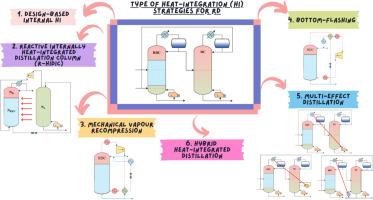反应精馏中的热集成:我们已经走了多远,还缺少什么?
IF 9
1区 工程技术
Q1 ENGINEERING, CHEMICAL
引用次数: 0
摘要
虽然已经发表了几篇关于反应精馏(RD)的综述论文,但没有一篇论文提供了重点分析,并整合了旨在提高反应精馏过程能源效率的热集成(HI)战略的全部范围。认识到研发是一种有前途的过程强化技术,本文探讨了促进研发过程中能量回收和再利用的各种HI策略。这些方法包括:(i)基于设计的改进,在没有额外设备的情况下实现内部HI,同时也识别出被忽视的设计变量,例如催化剂含率;(ii)热泵辅助方法,如内部热集成精馏塔(HIDiC)、机械蒸汽再压缩(MVR)和底部闪蒸(BF); (iii)多效配置;(iv)结合多种HI的混合方法。虽然这些战略被认为是成熟的,并且已经单独进行了审查,但现有的审查很少探讨如何对它们进行改进或组合以实现更大的研发节能。为了解决这一差距,本审查讨论了实际考虑和挑战,同时确定了在研发中实施HI战略的研究差距和未来前景。特别感兴趣的是新兴的双效HI。它利用在不同压力下运行的多个柱来显着减少外部公用事业需求。虽然这种方法已经显示出显著的节能效果,但其在研发中的应用仍然分散在个别研究中,尚未得到系统的审查。鉴于其前景广阔,对双效HI在RD中的作用进行全面评估是非常有价值的。总之,这篇综述旨在启发新的HI研究方向,以支持下一代可持续化学制造的发展。本文章由计算机程序翻译,如有差异,请以英文原文为准。

Heat integration in reactive distillation: How far have we come and what is still missing?
Although several review papers have been published on reactive distillation (RD), none have provided a focused analysis and consolidated the full range of heat-integration (HI) strategies aimed at enhancing the energy efficiency of RD process. Recognizing RD as a promising process intensification technique, this review explores the various HI strategies that facilitate energy recovery and reuse within RD process. These include: (i) design-based modifications, which achieve internal HI without additional equipment while also recognizing an overlooked design variable, e.g., catalyst holdup, (ii) heat-pump-assisted approaches such as internally heat-integrated distillation column (HIDiC), mechanical vapor recompression (MVR), and bottom flash (BF), (iii) multi-effect configurations, and (iv) hybrid approaches combining multiple HI. While these strategies are considered mature and have been reviewed individually, existing reviews rarely explore how they may be refined or combined to achieve greater energy savings for RD. To address this gap, this review discusses the practical considerations and challenges, alongside identifying research gaps and future prospects for implementing HI strategies in RD. Of particular interest is the emerging double-effect HI, which leverages upon multiple columns operating at different pressures to significantly reduce external utility demands. While this method has demonstrated notable energy savings, its application in RD remains scattered across individual studies and has yet to be systematically reviewed. Given its promising nature, a comprehensive review to critically evaluate the role of double-effect HI in RD is highly valuable. Overall, this review aims to inspire new HI directions in RD to support the advancement of next-generation sustainable chemical manufacturing.
求助全文
通过发布文献求助,成功后即可免费获取论文全文。
去求助
来源期刊

Separation and Purification Technology
工程技术-工程:化工
CiteScore
14.00
自引率
12.80%
发文量
2347
审稿时长
43 days
期刊介绍:
Separation and Purification Technology is a premier journal committed to sharing innovative methods for separation and purification in chemical and environmental engineering, encompassing both homogeneous solutions and heterogeneous mixtures. Our scope includes the separation and/or purification of liquids, vapors, and gases, as well as carbon capture and separation techniques. However, it's important to note that methods solely intended for analytical purposes are not within the scope of the journal. Additionally, disciplines such as soil science, polymer science, and metallurgy fall outside the purview of Separation and Purification Technology. Join us in advancing the field of separation and purification methods for sustainable solutions in chemical and environmental engineering.
 求助内容:
求助内容: 应助结果提醒方式:
应助结果提醒方式:


